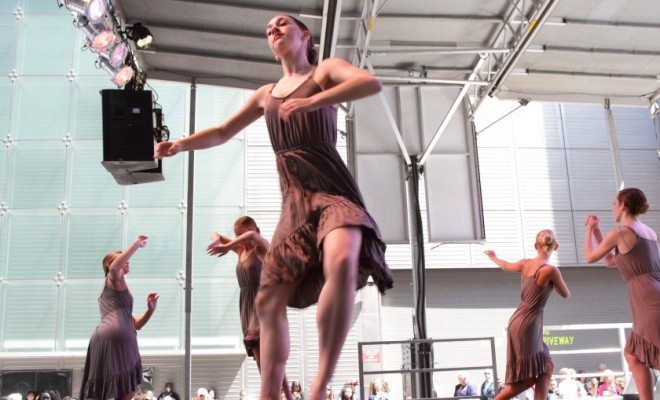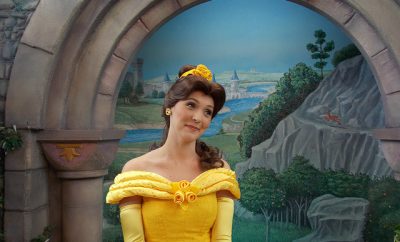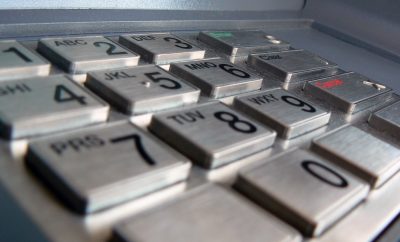 Image courtesy of [Paul Stein via Flickr]
Image courtesy of [Paul Stein via Flickr]
Entertainment & Culture
Who Owns a Dance? The Complexities of Copyrighting Choreography
From a walk through a subway station to prime time television, dance is all around us. However, with so many people throwing their feet into the game, choreography copyrighting has become a bit of a confusing mess. There is a basic part of choreography that many people do not understand: the creator of the dance does not always own the copyright to the moves. In many cases, especially with tour productions and Broadway musicals, the copyright actually belongs to the producers of the show.
It gets complicated when there are more than one or two people who have created the work, as is the case with many dance teams. There have been cases where a choreographer has simply listed other dancers in order to credit them for an idea or two (which can be as simple as a turn or a hand movement), without realizing that listing them actually gives that person the right to reproduce that work elsewhere.
So, how exactly can you copyright choreography? First, one has to define choreography. It is not as simple as a few dance moves strung together. Instead, Martha Traylor, a legal commentator, has suggested that we define dance as the “planned movement, set into a time frame, for the benefit and enjoyment of the passive observer.” She also notes that this broad definition of dance would provide statutory copyright protection for “everything from circus productions and stage movements of actors to figure skating.”
It can get confusing, but there are a few ways to analyze the complicated world of choreography copyrighting.
The Copyright Act of 1976
When we talk about copyright, the first thing we must turn to is the Copyright Act of 1976, which lays out the ground rules for the many different things that we can copyright. The choreography rules fall under different sections, including those for dramas and pantomime.
The act gives exclusive rights to copyright owners, which include:
- The right to make copies, either digitally or physically, of the work.
- The right to sell these copies to the general public.
- The right to use the work in a different capacity (derivative works).
- The right to perform the work in public and collect money for the performance.
These rights belong exclusively to the copyright holder, but can be sold to others to use the choreography. This often happens in new adaptions of older works, like a modernized musical.
But who owns the work in the first place? That depends on how the choreographer was hired.
The “Owner” of the Choreography
Most choreographers start out in a “work for hire” or freelance situation: they are brought in to choreograph something small for a theme park, a small-time music video, or a commercial. In this case, the employer owns the work that the choreographer creates. As the person hired is technically an employee of the entity, that piece of work now belongs to the company that did the hiring.
Some choreographers, especially those who are more well-known, will try to negotiate the rights to a particular piece of dance with varying levels of success.
One of the most beloved routines from the last hundred years has been the choreography in West Side Story. The moves are iconic to those in the know. However, it is also a work that many try to steal or emulate–and the copyright owners are watching. In a recent season of Dancing with the Stars, one of the pros tried to recreate the choreography. However, they couldn’t use any of the iconic moves. If they did so, it could have caused ABC some major problems. What resulted was a dance that reflected the style of the musical, but didn’t use the same routine.
One of the most well known court cases in choreography was the Martha Graham case, where a copyright controversy came up upon the death of beloved artist Martha Graham. She had established a dance school where she helped create over 50 pieces of work that were shown on the stage. However, she never established a copyright to the works between her and the school that she founded.
The case went to trial in 2002. The court used the work for hire law and established that “that 45 pieces were owned by the center and school, five belonged to those who had commissioned them, one belonged to the heir, 10 were in the public domain, and no one could prove ownership of nine works.” Her family lost out on potential profit because they couldn’t prove they were her design.
While this was a mistake made by a bigger artist, many small time choreographers have had similar problems.
More Than One Owner
Today, many shows, tours, or dance troupes will have more than one choreographer that helps to prepare the dances. Often, this includes a main choreographer and someone that assists them. In this case, there can be two or more owners of the copyright. However, it can only be considered a “joint work” if their work is combined and it is inseparable or interdependent on the other contributor’s work.
The U.S. Copyright Office considers joint copyright owners as equals–meaning that one person does not have more rights to the piece than the other person. In fact, unless the joint owners make a written agreement, each copyright owner has the right to commercially exploit the copyright. However, that does not mean that one person can just up and run with the piece–the other person needs to get an equal share of the profits, or the other half can buy them out if they think that will be more profitable.
Musical Copyright and Dance
While music is its own beast when it comes to copyright, there are also considerations you need to take with music and choreography. Think of the dances that we know best: the Macarena, the Single Ladies routine, the “Chorus Line” moves, and even the dancing from “Pitch Perfect”–they all are dependent on the music they accompany. All copyrighted popular music resides in the catalog of “performing rights organizations,” like the American Society of Composers, Authors and Publishers (ASCAP). Getting the rights to those songs often takes a long time and costs a lot of money.
Getting the music for a number is explained by Dance USA:
If a work was published in 1923 or later (that is, you are looking at a printed score and the copyright notice is dated 1923), it is protected by U.S. copyright law in this country. In addition, a large group of works, largely of Russian but also other origin, was restored to copyright in 1996 for the U.S. under GATT. The 20 year extension put into law in 1998 also has an impact on the works covered by this treaty.
If a work is a 20th or 21st century arrangement of an existing work, whether the underlying work is still protected by copyright or already in the public domain, you will need to clear performance rights.
Getting those rights will require a lot of knowledge from the choreographer: like what they are using it for, the size of the performance, and the cost of tickets.
Conclusion
Overall, getting the rights to a piece of work or even copyrighting your own work can be confusing. Choreography, like any other form of art, is protected and heavily regulated. The confusing web of laws surrounding the industry have led to problems for some, but at the end of the day, protects those who invest their time into creating the dances and musical numbers we all are able to enjoy on screen or on stage.
Resources
Primary
U.S. Congress: The Copyright Act of 1976
U.S. Congress: Copyright Law Revision
Additional
Dance USA: Guide to Music Rights for Perplexed Choreographers
AVOO: The Business of Choreography: The Relationship between Copyright and Dance
Dance USA: Music Licensing 101: The Pretty to the Nitty-gritty
Gallagher, Callahan, & Gartrell: Copyright Basics for Musicians
Kent Law: Copyright and Choreography: What Constitutes Fixation?
New England Law Review: Choreography, Pantomime and the Copyright Revision Act of 1976
New Leaf Legal: DWTS and “West Side Story” Copyright Issues: Explanation and Speculation
Copyright Crash Course: Who Owns That?








Comments